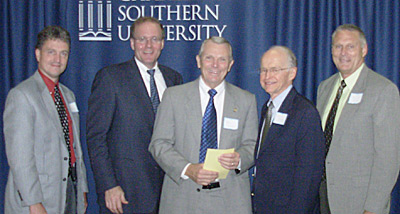Meeting at Charleston Southern University Oct. 1, members of the South Carolina Baptist Historical Society pondered the question, “What is a Baptist university?”
 Clay Waldrip of First Baptist, Chester; John Adams (second from left) of First Baptist, Easley; Glenn Clayton (second from right), SCBC history consultant; and SCBC executive director-treasurer Jim Austin visit with university president Jairy Hunter (center) during the Historical Society meeting on the Charleston Southern campus.
Clay Waldrip of First Baptist, Chester; John Adams (second from left) of First Baptist, Easley; Glenn Clayton (second from right), SCBC history consultant; and SCBC executive director-treasurer Jim Austin visit with university president Jairy Hunter (center) during the Historical Society meeting on the Charleston Southern campus.“I deliver this lecture as a debt of love to my son, whom I want to enter a first-rate university committed to academic excellence and to a deeply informed, held and cherished Christian tradition,” began keynote speaker John Adams, president of the society and pastor of Easley’s First Baptist Church.
In attempting to define “Baptist,” Adams pointed to distinctive tenets such as priesthood of the believer, soul competency, believer’s baptism and regenerate church membership, congregational polity, autonomy of the local church, the lordship of Jesus Christ, and a commitment to religious liberty and the separation of church and state.
“How does the above list relate to the university?” Adams asked. He highlighted several ways, including a focus on scripture and the lordship of Jesus Christ; on an awareness of being dissenters, who can stand outside the norm of society and critique it; on espousing religious freedom; and on being transformational in the belief that Jesus Christ can change lives.
“We should be unapologetically Christian in our orientation, yet be open-spirited to those students who may come into our university and not have a reference point of faith or a different reference point,” he maintained.
“Another way I believe we can address the university is that of the priesthood of the believer and the competency of the soul,” Adams said. “If ever there should be a university that treasures each other’s opinion and fosters a community from the ground up, it should be a Baptist university.”
In defining the university, Adams emphasized that its center should be its students and faculty. “When my son is old enough to enter a university, I want them to have his best interests in mind,” he explained. “I want him to come into a transforming environment that is academically sound and thriving.”
Observing that a university must be a community of learners who are committed to the discovery and dissemination of truth, he advocated, “The commitment to free and open inquiry must also remain a foundation stone in the building of a good university.
Drawing upon the work of Lutheran scholar Robert Benne, Adams outlined four expressions of church-related universities in contemporary society: accidentally pluralistic, intentionally pluralistic, critical mass and orthodox. He voiced a preference toward the critical mass school, which attempts to heavily recruit students and faculty from the sponsoring denomination, but does not seek 100 percent representation of its tradition in every aspect of academic life.
The society’s meeting at Charleston Southern University was the second in a series of programs focusing on “Baptist Higher Education: Past, Present and Prospect.” The Baptist higher education programs are in lieu of the society’s usual two annual meetings, one of which has traditionally been held during the South Carolina Baptist Convention’s annual meeting in November.
The Historical Society’s 2008 meeting will be held on the campus of North Greenville University. The date will be announced later.
